ÉDOUARD MANET
Édouard Manet ( 1832 -1883)
The son of a senior official in the Department of Justice, Manet was a well known figure in social circles in Paris. He trained with the artist Thomas Couture for six years during the 1850’s. As an apprentice painter, the young Manet spent much time in the Louvre copying the old masters, he was especially impressed by Spanish artist Velásquez.
As a young painter during the 1860’s, Manets ambition was to exhibit in the Salon. ( This was the main outlet to exhibit paintings in Paris). The Academy who selected paintings for exhibition were not impressed by Manet’s work. In 1863 an opportunity came Manets way – A “Salon des Refuses” was established to exhibit work that was not selected by the Academy. Manet exhibited a large painting called ‘Le Dejeuner sur l’ Herb’ (Luncheon on the Grass) which shocked audiences and instantly caused Manet a lot of negative attention.
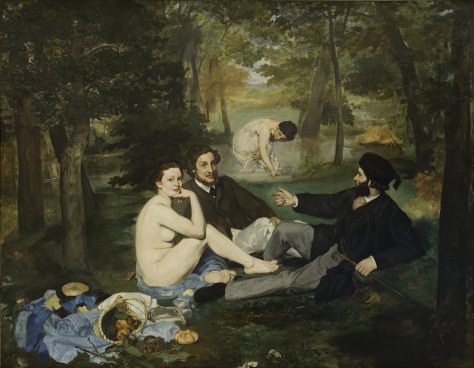
In ‘Dejeuner sur l’Herb’ a nude woman sits on the ground beside two fully clothed men. In the background another woman is dressed only in her undergarments; she is bathing herself in a river. Manet was criticised on both moral and artistic grounds for displaying a nude figure in such a setting and for his loose quick painting style.
This short video discusses the use of light and brushwork in ‘Déjeuner sur l’Herb’.
Olympia (1965); When this painting was exhibited it caused even more outrage than Déjeuner sur L’Herb. A nude woman looks directly out at us from her bed. “ Olympia” was known at that time in Paris as a name typical of a prostitute. Not only was the painting scorned on moral grounds but Manet’s painting technique was highly criticised. The brushwork was too loose, the nude figure was too pale and washed out looking, the painting style was too flat for the critics.


Manet had based Olympia on a painting by the Renaissance artist Titian; “The Venus of Urbino”. Whereas the nude figure in Titians work was accepted as a beautiful godess, Olympia in contrast, caused consternation amongst the Paris audiences and was rejected as shocking and brazen.
It is believed that Manet was greatly influenced by Photography and by Japanese prints when painting ‘Olympia’. The nude figure is very pale, there is hardly any shadows on her. This is similar in effect to a photograph with strong or over exposure to light. ‘Olympia’ is painted very flatly; there is hardly no modelling on her body and Manet paints with black outlines around the figure. This is similar in style to Japanese prints.
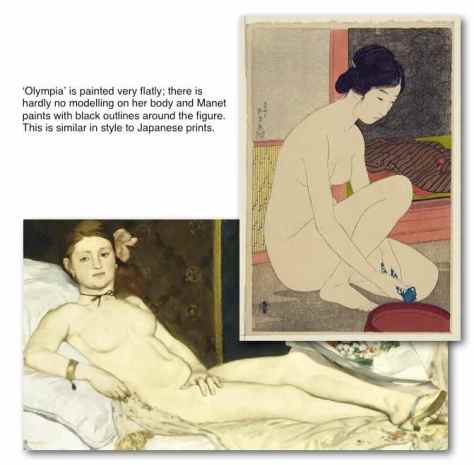
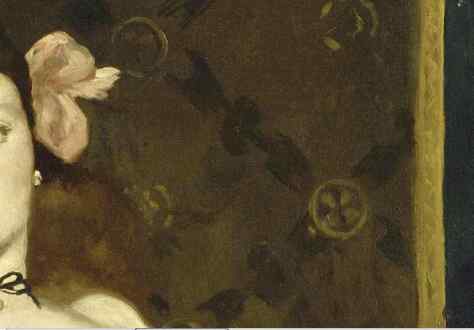
In 1882 Manet painted “ A Bar at the Folies- Bergére”. In contrast to “Dejeuner sur l’ Herb” and “Olympia” ; it was accepted by the Paris Salon and exhibited there to great acclaim from critics and audiences. It was Manet’s last great painting before his death in 1883. A young barmaid is standing behind the bar gazing out. Behind her is a large mirror that reflects the scene before the barmaid which she looks out upon.
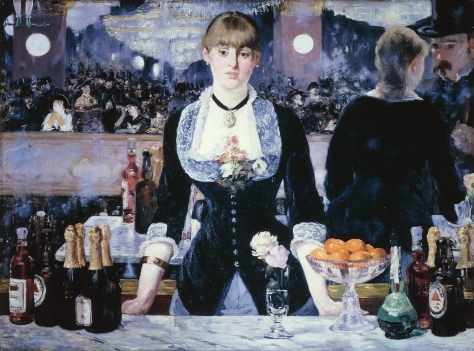
This painting is an intricate web of viewpoints.The barmaid gazes out – not at us – but instead stares into space. It is impossible to tell what she is thinking. In the mirror behind her we can see her reflection and a man is standing directly infront of her yet Manet chooses only to paint this man in the reflection not in reality. He should be standing in the front of the painting with his back to us. Manet places the reflection of the barmaid off-centre, it should be directly behind her in the mirror. Manet plays tricks with our perceptions. Its really a painting about seeing and looking. The scene that the barmaid is gazing out upon is one of hundreds of people who are reflected in the mirror behind her. Manet paints this crowd very loosely, capturing just fleeting impressions of the people as they disappear in and out of smoke and lights. “A Bar at the Folies Bergére is considered to be one of the masterpieces of the 19th Century.

It is a complex composition yet Manet still uses the traditional foreground, middle ground and background. In the foreground, along with the barmaid there is a still life of bottles, flowers and a bowl of oranges. This still life is painted in a more defined way than the rest of the painting. These objects appear in-focus with light glinting off the top of the shapes.
In the middle ground of the painting Manet paints the refections of the barmaid and the male customer together with the refections of the bottles. This middle ground is painted far more loosely than the foreground, making it appear to receed from the foreground. Finally in the background Manet paints very loosely, describing people in just a few quick brushstokes. We can make out very little detail on these people. The crowd appear out of focus and receeds into the distance. Manet uses the traditional composition of fore, middle and back grounds to achieve perspective.
In the middle ground of the painting Manet paints the refections of the barmaid and the male customer together with the refections of the bottles. This middle ground is painted far more loosely than the foreground, making it appear to receed from the foreground. Finally in the background Manet paints very loosely, describing people in just a few quick brushstokes. We can make out very little detail on these people. The crowd appear out of focus and receeds into the distance. Manet uses the traditional composition of fore, middle and back grounds to achieve perspective.
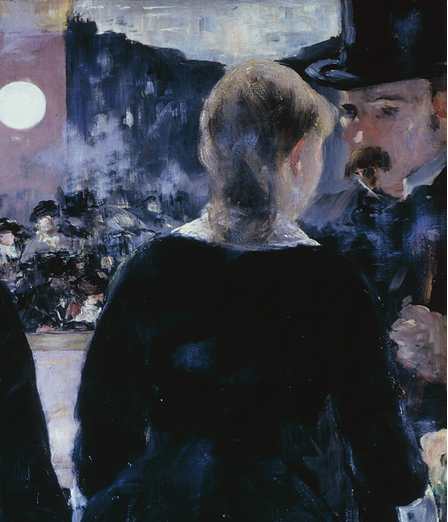
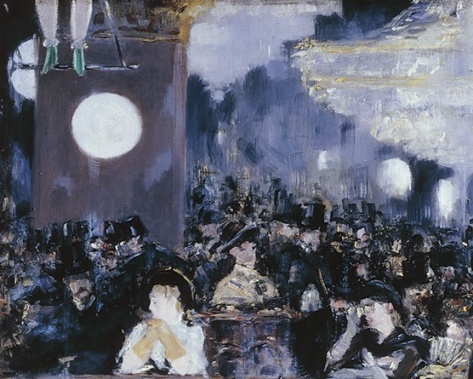
CLAUDE MONET
Claude Monet ( 1840 – 1926)
Monet is regarded as central to the Impressionist movement in that he followed the philosophy and principles of Impressionism all his career. Monet painted much of his works Plein Air ( outside looking directly at the subject) and was concerned with how the colour of things changed in different weather and atmosphere. “ Color is my day-long obsession, joy and torment! ” .
Claude Monet was born in Paris but grew up in Le Harvre where he was influenced by the artist Eugéne Boudin who encouraged him to take up Plein Air painting. In 1862, after a spell in the French Army, Monet began to study art under Charles Gleyre in Paris. It was in Paris that he met other artists such as Renoir and Pissaro who had similar interests in colour, light and brushstokes as him, it was these artists who would go on to form the ”Impressionists”.
“Women in the Garden” 1866/67 was painted ourdoors by the young Monet. The painting was so large he had to dig a trench so that the painting could be lowered for him to reach it. Monet’s concern for the effects of light and shadow is quite visible in this early painting. The bold brushwork which is always a feature of his work is already there at this early stage in his career.

In 1874, Monet exhibited his painting “Impression; Sunrise” (1872) at the first Impressionist
Exhibition. The art critics reacted strongly to this painting because it was an “ Impression’ rather than an exact painting of a harbour at sunrise. One critic – Louis Leroy wrote that all the paintings in the exhibition were ‘Impressions” and the name stuck. This is how Impressionism came to be.
Exhibition. The art critics reacted strongly to this painting because it was an “ Impression’ rather than an exact painting of a harbour at sunrise. One critic – Louis Leroy wrote that all the paintings in the exhibition were ‘Impressions” and the name stuck. This is how Impressionism came to be.
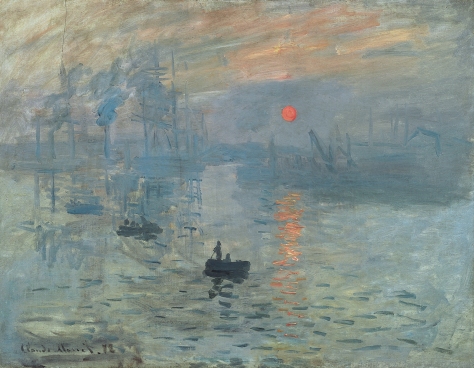
The painting is of the harbour at Le Havre at dawn. It appears to be foggy. Monet uses mostly blues except for orange which he uses on the sun,an orange tint in the clouds and the orange reflections of the sun in the water. As the title suggests he captures an impression of the scene rather than painting in the exact details.
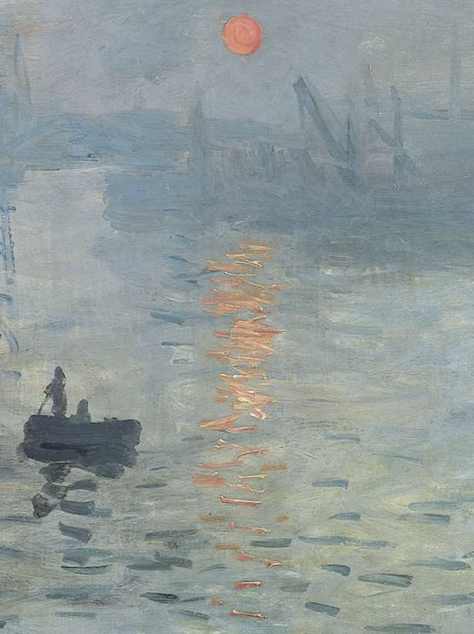
From the 1880′s onwards Monet began to paint in series – he took a subject matter and painted a series of it – over and over , in different lighting and weather conditions.The most famous of these series are his paintings of Rouen Cathedral ( below) and of haystacks ( further below).

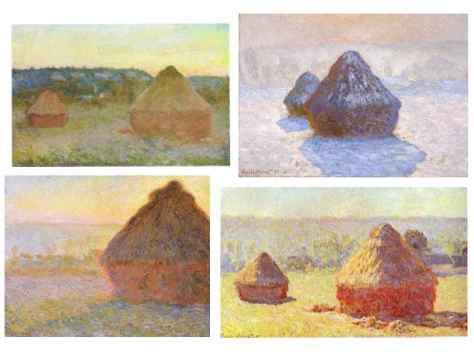
In 1890 Claude Monet bought a house and land in Giverny. He built a magnificent garden there and spent the rest of his life living there until his death in 1926. He painted scenes from his garden – the pond and bridge, flowers, trees and his most famous series of waterlilies. At the end of his life Monet’s paintings became more and more abstract – he was always concerned with capturing an impression and as he aged his sight began to fail; Monet’s painting took on an abstract appearance where colourful marks and brushstrokes dominate the viewers senses. At times its difficult to make out what the painting is about – the viewer needs to step back and appreciate the impression and mood that Monet is creating.

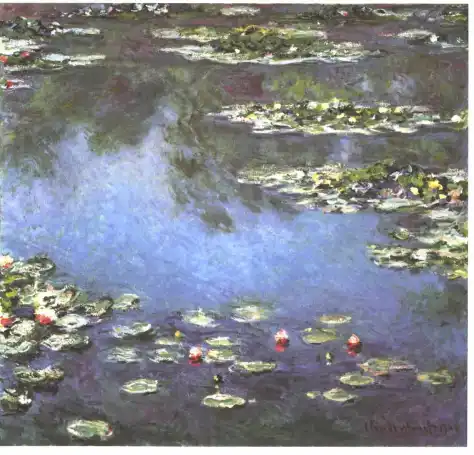

Fauvism
See Link for Notes:
See Video for Fauvism Overview:
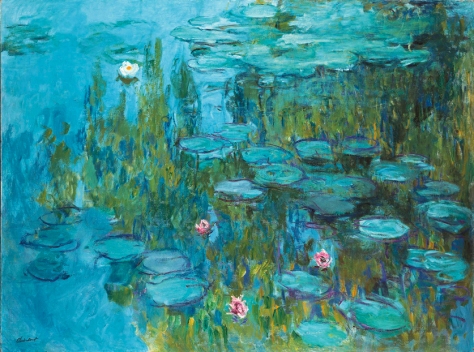
A very interesting article... may I share an Interview with Vincent van Gogh(imaginary) in http://stenote.blogspot.com/2016/07/an-interview-with-vincent.html
ReplyDelete